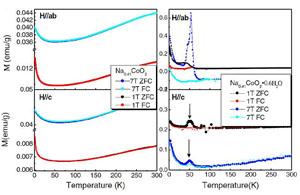
Temperature-dependent magnetization of high quality single crystals of hydrated and non-hydrated Na0.41CoO2. This shows that hydration drives NaCoO2 towards ferromagnetism, implying triplet superconductivity.
Hydrated sodium cobalt oxide was shown to be near a ferromagnetic quantum critical point implying that the superconductivity exhibited is of triplet nature. This was possible by performing transport and magnetic measurements of susceptibility and scattering on highly perfect single crystals, and combining the results with MSED-funded theory. The critical temperatures of approximately 5 K that were previously found in this system are remarkably high for a triplet, which in combination with the present results points to a very strong pairing strength. The present work shows key effects of hydration to be screening of the charge ordering effect of sodium on the local electronic structure and an increasing ferromagnetic tendency. Such a ferromagnetic tendency is incompatible with conventional singlet superconductivity but agrees with triplet state pairing. The key feature of a triplet superconductor is that the Cooper pairs carry spin. The availability of a practical triplet superconductor with a critical temperature above the boiling point of liquid helium opens up new opportunities for superconducting electronics, detectors and quantum devices.
For more information, please contact David Singh, singhdj@ornl.gov.
G. Cao, M. M. Korshunov, Y. Gao, M. Le Tacon, D. J. Singh, and C. Lin, "Anomalous in-plane electronic scattering in charge ordered Na0.41CoO2.0.6H2O," Phys. Rev. Lett. 108, 236401 (2012).

